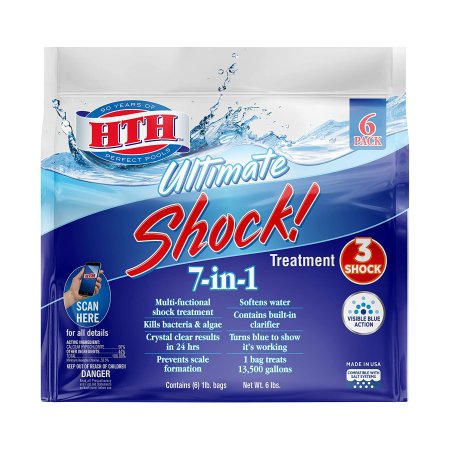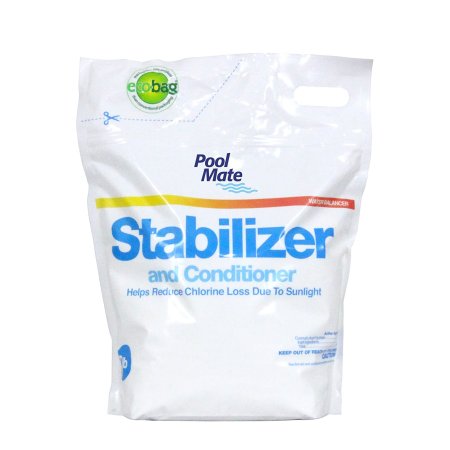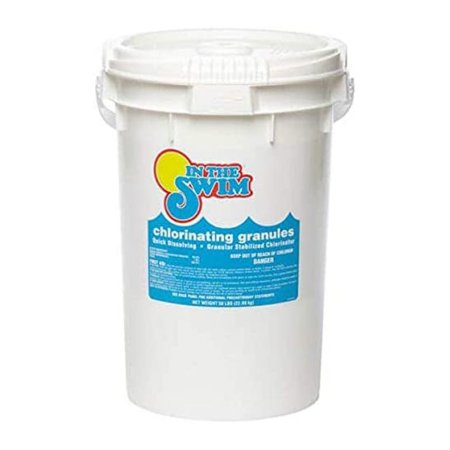We may earn revenue from the products available on this page and participate in affiliate programs.
Reading up on Domino’s shopping guides is like having your own personal product concierge. We do the tedious part—deep-dive research, hands-on testing, and tapping experts for advice—so all you have to do is hit “add to cart.” That’s why we call them Simply the Best.
Unless you’re the type to keep up on pool maintenance every week (if so, claps), there’s a good chance you’ll come outside one morning to find a green haze creeping across the bottom of your pool. While algicide might be one solution, a full-on algae bloom might necessitate shocking your pool. What’s that, you ask? A good pool shock contains a high concentration of chlorine, which will kill off any algae and bacteria, making a pool safe for swimmers again. (Not always an ideal situation to be in, but sometimes it must be done.)
Once you get your water back to sparkling, adding a pool stabilizer into your routine will help prevent you from having to do so again. But first: Read on for some of the best pool shocks for getting rid of algae and bacteria, and then get right back to lounging and laps.
Our Favorites
- Best overall: HTH Ultimate Shock Treatment
- Best chlorine-free: In the Swim Chlorine-Free Pool Shock
- Best chlorine stabilizer: Pool Mate Swimming Pool Stabilizer
- Best for algae blooms: Zappit Cal-Hypo Pool Shock
- Best di-chlorine shock: In the Swim Sodium Di-Chlor Chlorine
Best Overall: HTH Ultimate Shock Treatment
Best Overall
Shop NowForm: Six 1-pound bags | Chlorine level: 56 percent | Treats: 13,500 gallons
What we like:
- Softens and clarifies in addition to sanitizing
- Comes in individual bags
- Turns blue to show it’s working
Worth noting:
- Lower percentage of calcium hypochlorite than other pool shocks
Why we chose it: A less harsh shock that comes individually portioned.
With its 56 percent chlorine concentration, HTH’s version isn’t as harsh as other pool shocks, and it includes additives that will help return your pool water to pristine condition after it kills off the algae. In addition to removing harmful bacteria and any green stuff clinging to your pool walls, HTH has a clarifier that will take your pool from cloudy to crystal clear. While this product includes calcium, which can make your pool water hard, an added softening agent in the shock helps counter that. We also love the fact that HTH turns blue after you apply it; you won’t need to stand at the edge wondering if it’s working. And since it comes in individual bags, there’s no messy scooping and measuring.
Best Chlorine Free: In the Swim Chlorine-Free Pool Shock
Best Chlorine Free
Shop NowForm: 1-pound bags | Chlorine level: None | Treats: 10,000 gallons per bag
What we like:
- Lessens a pool’s dependence on chlorine
- Comes in convenient single-serving bags
- Won’t throw your pool’s pH out of whack
Worth noting:
- Not a replacement for chlorine shock
- Not effective at fighting off algae blooms
Why we chose it: It won’t eliminate the need for chlorine, but this shock will lessen how much you need to add.
If the thought of dumping chlorine into your pool makes your eyes twitch, there’s an alternative. This shock from In the Swim uses potassium monopersulfate as its active ingredient instead of chlorine. It works by burning away dead chlorine cells, making room for free chlorine to deal with bacteria and algae. Since this product is chlorine-free, it won’t throw off your pool’s pH levels or make you wait for a dip—water is safe for swimming just 15 minutes after applying it. Keep in mind that you can’t use this shock for all your sanitizing needs; it works to help maintain chlorine levels. While it lessens your pool’s dependence on chlorine, if you’re looking for a shock to take down an algae bloom, this isn’t it.
Best Chlorine Stabilizer: Pool Mate Swimming Pool Stabilizer
Best Chlorine Stabilizer
Shop NowForm: 7-pound bag | Chlorine level: None | Treats: 4 ounces treats 10,000 gallons
What we like:
- Eliminates the need to use shock
- Preserves existing chlorine in the pool
Worth noting:
- Not effective for large algae blooms
Why we chose it: Pool Mate stabilizer keeps your pool’s chlorine levels consistent so there’s no need for shock.
Not to get all woo-woo, but an ounce of prevention is worth a pound of cure, and that holds true when it comes to treating pools. The best way to keep a pool clear and algae-free is by never having to use shock in the first place. This stabilizer from Pool Mate will help you do so by increasing the level of cyanuric acid in the water. Pool Mate stabilizer serves as a shield that prevents the sun’s UV rays from breaking down chlorine in the water, reducing your need for the chemical by about 25 percent. Add 4 ounces for every 10,000 gallons to keep the stabilizer level in your pool’s water at the optimal level of 40 parts per million, and you can cut down on how much chlorine you need to dump in your pool.
Best for Algae Blooms: Zappit Cal-Hypo Pool Shock
Best for Algae Blooms
Shop NowForm: 50-pound bucket | Chlorine level: 73 percent | Treats: Fifty 40,000 gallon treatments
What we like:
- Will last you all summer long
- Good for odd-size pools
- Strong potency
Worth noting:
- Can potentially stain if not careful
- Must measure out specific amounts
Why we chose it: You won’t find a more powerful shock treatment for facing off against large algae blooms.
If algae is running amuck in your pool, you may need a shock with a little awe in it. With its 73 percent chlorine content, Zappit just might be the answer. You’re going to want to tread carefully here, though: This shock is powerful enough to potentially bleach the pool bottom and walls, so mix it in a bucket before use and vacuum up any undissolved particles you spot after applying it. Zappit comes in a 50-gallon bucket, which is cumbersome to carry but more than enough shock to keep your water clean for the entire summer. You’ll also need to measure out treatments with a measuring cup, which is more work than opening a package and dumping. But that can be an advantage if you have a pool size that doesn’t mesh with single-serve chlorine bags.
Best Shock Alternative: In the Swim Sodium Di-Chlor Chlorine
Best Shock Alternative
Shop NowForm: 40-pound tub | Chlorine level: 56 percent | Treats: 1 pound treats 10,000 gallons
What we like:
- Lower chlorine content
- Can use during the day
- No calcium content
Worth noting:
- Not suitable for larger algae blooms
- Large, cumbersome container
Why we chose it: With no calcium additive and a lower chlorine content, this shock has less of an impact on your pool’s chemistry than traditional pool shock.
One of the problems with conventional pool shock is that it can throw your pool’s chemistry out of whack, increasing the pH with large amounts of chlorine. Traditional shocks also use the mineral calcium, something you don’t want in your pool if you already have problems with scaling. In the Swim Sodium Di-Chlor Chlorine is an alternative. It doesn’t have calcium, so it won’t add minerals that can harden the water, and, since it contains cyanuric acid, you can add it during the day without the risk of the chlorine burning off under the sun’s UV rays. To note: It has a lower (56 percent) concentration of chlorine, so it won’t be as effective as stronger shocks if you’re battling a large algae bloom.
How We Chose These Products
In general, pool owners should try not to use pool shock—it can easily throw off pH or water hardness—under normal conditions if you’re regularly using chlorine. But sometimes it’s unavoidable, especially if you’re dealing with an algae invasion. So to find the best pool shocks, we began by researching products that would kill algae and bacteria while having the least impact on your pool’s delicate chemistry. With that in mind, we favored options with lower concentrations of calcium hypochlorite and additives. We also included a pool stabilizer, which helps to maintain proper chlorine levels in the pool with no need to use shock, and some chlorine-free shock alternatives. When you need to deal with the tough stuff, we chose products with high concentrations of chlorine capable of managing large algae blooms.
Our Shopping Checklist
Types of Pool Shocks
Calcium hypochlorite: Often referred to as cal hypo, this is the most common type of pool shock. It typically comes with either 73 percent or 65 percent chlorine concentration and doesn’t include any additives such as clarifiers and stabilizers. It is best used in the evening, as the sun is going down, to prevent the chlorine from burning off in the sun’s UV rays. While this high-concentration pool shock will raise the chlorine level of your pool and effectively wipe out algae and bacteria in the process, it will also raise the water’s pH level along with its calcium levels, potentially making the water harder. This type of shock will also boost your pool’s free chlorine concentration beyond safe levels, keeping it out of service for up to eight hours.
Sodium di-chlor: This has several advantages over standard cal hypo shock. With its lower 56 percent concentration of chlorine, pool water is typically safe to swim in within an hour of application; it also includes a pool stabilizer that protects chlorine from UV rays, so it’s safe to use during the day. Sodium di-chlor doesn’t have calcium in it, so it won’t increase the hardness in your pool water like other shocks. And since it has a neutral pH, it won’t throw off your pool’s pH level, though it will boost total cyanuric acid levels. While these qualities make sodium di-chlor a great option for stabilizing chlorine levels, it isn’t powerful enough to take on bigger algae blooms.
Potassium monopersulfate: In layman’s terms, this difficult-to-pronounce name is simply called non-chlorine shock—it works by boosting free chlorine in pools. Since it doesn’t contain the chemical, it’s a great option for pools that use bromine instead of chlorine to sanitize water. And since it dissolves quickly, swimmers can return to the water just 15 minutes after treatment. But remember: While non-chlorine shock is great for preserving your pool’s chlorine levels, it won’t help you with an algae bloom.
Chlorine and pH Levels
Regardless of how much chlorine you add to your water, the chlorine level should be between 2 to 4 parts per million (PPM) to maintain a safe pool. Going above that will lead to red eyes and the dreaded swimmer’s itch. Below that and you’re asking for an algae bloom.
While shock will raise a low chlorine level, it really only should be used when algae blooms get out of control. As mentioned earlier, shock can throw a pool’s pH balance out of whack, requiring you to use more chemicals to get it back into the proper balance (not ideal). There’s also the risk of staining if undissolved granules are allowed to collect on a pool’s walls or bottom. Owners should try to skirt all of this with regular maintenance, says Caleb Brown, owner of Southern California–based Living Pool Water Service.
“The objective is to maintain a low, steady level of chlorine in a pool so you don’t have to shock it,” Brown says. “The two main ideas are chlorination and filtration. If those two things are working hand in hand, then you should be in good condition.” A good stabilizer, which consists of cyanuric acid, will help keep those chlorine levels stable. Even an algae bloom can be remedied without the need for shock by using a good algicide and extended filtration, Brown says, though there are instances when a pool shock might be necessary. “There are, of course, times that algae will get out of hand, and in that situation, you will have to shock, but that’s not our first strategy.”
Dissolving Time
How long it takes shock to dissolve is crucial knowledge to have for protecting the pool walls and bottom from potential staining. If it doesn’t dissolve quickly and is allowed to settle, you could end up with a bleached pool bottom, especially if yours has a liner. Generally, the higher concentration of cal hypo in the pool, the greater the risk you’ll end up with undissolved granules. As noted above, the best way to avoid this is by mixing the shock in a bucket of water before dumping it in.
Ask Domino
Q: Can I add shock and algicide at the same time?
While both shock and algicide are effective ways to rid your pool of algae, they shouldn’t be added together, as the combo will neutralize algae-killing abilities. Instead shock the pool, then wait for the chlorine level to fall below 4 PPM before adding algicide to prevent future algae growth.
Q: Should I backwash after shocking the pool?
Backwashing and shocking both help to improve water quality in the pool: Backwashing unclogs the filter so it can better perform its job, while, as we know, shock kills bacteria and algae. After shocking, monitor the pressure gauge reading on the filter. If the pressure rises significantly, it means the filter is clogged with debris and needs to be backwashed to clear it out.
Q: Can you shock a pool two days in a row?
While it’s okay to shock your pool two days in a row, it shouldn’t be done unless absolutely necessary. This can throw off the pool’s pH and overall chemistry, forcing you to use other chemicals to get the pool water back to optimal condition. Pool shock can also be used every once in a great while as a preventative measure if your chlorine is low, you just hosted a big pool party, it’s been raining pretty hard, or, of course, you spot a little bit of green growing. The most important thing is getting the water in balance.
Q: Should I use shock or algicide first?
If you’re treating a bad algae bloom, use shock first to get the algae under control and then wait to add the algicide until the chlorine levels in the pool fall to a level that’s safe for swimming.
The Last Word
If you’re on top of pool maintenance, you’re adding chlorine tablets to the skimmer to maintain proper levels and backwashing the filter regularly so algae doesn’t have an opportunity to take root. But if the answer is no, or you’ve fallen behind and end up with an algae bloom, HTH Ultimate Shock Treatment is one of the best pool shocks for getting rid of that algae and returning your pool to normal levels. Once that’s happened, make sure to use Pool Mate Swimming Pool Stabilizer to preserve free chlorine and prevent that algae from coming back.





